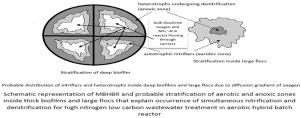Journal of Environmental Chemical Engineering ( IF 7.4 ) Pub Date : 2020-10-17 , DOI: 10.1016/j.jece.2020.104589 Roumi Bhattacharya , Debabrata Mazumder

|
Nitrification kinetics of wastewater characterized by high nitrogen and very low organic carbon was evaluated using a moving bed hybrid bioreactor (MBHBR) in batch mode by varying initial ammonium nitrogen (NH4+-N) concentration in the range of (500–1000) mg L-1 at a pH of 7.8 ± 0.15 and temperature around 28 ± 2. A maximum removal efficiency of 89% in terms of ammonium nitrogen was achieved with initial NH4+-N concentration of 900 mg L-1 having a total biomass concentration around 2000 mg L-1 and at a batch period of 5 days. The experimental results were analyzed in the light of Monod’s kinetic theory and coefficients for nitrification were obtained as maximum substrate removal rate coefficient (µmax) = 0.52 day-1, yield coefficient (Y) = 0.63 mg VSS/mg NH4+-N, half saturation constant (Ks) =603.11 mg NH4+-NL-1 and endogenous decay constant (kd) = 0.008 day-1. The study confirms better nitrification efficiency in presence of attached biomass as compared to suspended growth condition. An interesting observation from the nitrate nitrogen profile establishes the possibility of denitrification, occurring simultaneously even in absence of organic carbon in the wastewater in aerobic MBHBR. This can be supported by the fact that the suspended flocs and/or attached biofilms in hybrid reactor was deep enough for creating necessary conditions for denitrification and the required organic carbon was partially obtained from endogenous degradation of the microorganisms.
中文翻译:

移动床混合生物反应器处理富氨氮废水的硝化动力学评价
使用移动床混合生物反应器(MBHBR)以间歇模式通过在(500–1000)mg范围内改变初始铵态氮(NH 4 + -N)浓度来评估以高氮和极低有机碳为特征的废水的硝化动力学。在7.8±0.15的pH和28±2的温度下的L -1。在900天的L NH 4 + -N初始浓度为900 mg L -1时,总生物量浓度为2000 mg L -1,分批处理5天,氨氮的最大去除效率达到了89%。根据Monod动力学理论分析了实验结果,得出硝化系数为最大底物去除率系数(µ max)= 0.52 day -1,产率系数(Y)= 0.63 mg VSS / mg NH 4 + -N ,半饱和常数(K小号)= 603.11毫克NH 4 + -NL -1和内源性衰变常数(k d)= 0.008天-1。该研究证实,与悬浮生长条件相比,存在附着生物质时硝化效率更高。来自硝酸盐氮分布的有趣观察确定了反硝化的可能性,即使在好氧MBHBR的废水中没有有机碳的情况下也会同时发生。混合反应器中悬浮的絮凝物和/或附着的生物膜足够深,可以为反硝化创造必要的条件,而所需的有机碳则是由微生物的内源降解部分获得的,这可以得到支持。









































 京公网安备 11010802027423号
京公网安备 11010802027423号